Betting on a shore thing
September 19, 2013
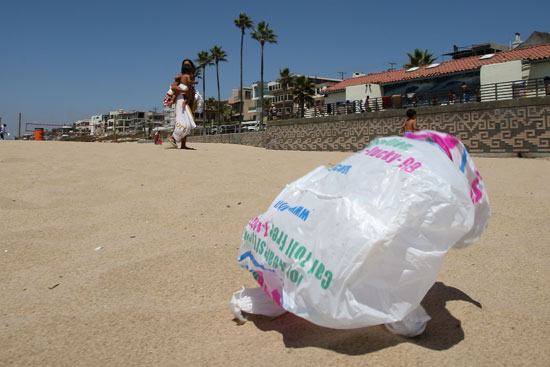
With plastic bag bans taking hold across the state, officials say our beaches are becoming beneficiaries.
At the end of each summer, the beach gets a close-up.
On the annual Coastal Cleanup Day, which occurs again on Saturday, thousands head to beaches and watersheds to pitch in during what’s billed as the largest volunteer event in the world. The junk they collect provides a troubling snapshot of how some of our bad habits can affect the environment.
During last year’s cleanup, a whopping 516,798 pounds of debris was collected statewide. The biggest offender was cigarette butts, accounting for 217,423 pounds, or 42 percent of the total. But plenty of other stuff was collected, too, including 94,182 pounds of food wrappers and containers, 43,783 pounds of plastic bags, 1,159 pounds of condoms, 1,187 pounds of six-pack holders and 508 pounds of syringes. You get the idea.
In L.A. County alone, 43,427 total pounds of debris was picked up last year, despite a volunteer turnout that was significantly reduced by triple-digit temperatures.
Still, the numbers offer a ray of hope. Eben Schwartz, who organizes the statewide volunteer push for the California Coastal Commission, said plastic bags, which take hundreds of years to decompose, are declining in jurisdictions that have enacted restrictions.
“In San Francisco, bags are way down the past couple of years,” Schwartz said.
Bans on single-use plastic bags started in the Bay Area around 2007 and are now banned throughout Alameda County. L.A. County banned plastic bags in 2010, but the ordinance only applied to county facilities and unincorporated areas, representing a small slice of the region’s total population. Other jurisdictions have since followed suit. In June, the City of Los Angeles got on board with an ordinance that will take effect next summer.
“On future cleanup days,” Schwartz predicted, “there’s going to be a whole lot less plastic bags in Los Angeles.”
Officials say that other government measures appear to be having an impact, too, including bans on Styrofoam containers and the installation of storm-drain screens to catch debris. The amount of trash collected statewide during Coastal Cleanup Day 2012 was just 12 pounds per person, down from 19 pounds in 2011, 15 pounds in 2010 and 17 pounds in 2009.
Over the past decade, catch basin screens have been installed in storm drains throughout L.A. County, said Kerjon Lee, spokesperson for the county’s Department of Public Works. The basins block trash from entering inland waterways and reaching the ocean.
Further downstream, Lee said, trash booms are deployed after rain storms to catch debris that has made it down flood channels and rivers. “They are good systems but they are end of the pipe systems,” Lee said of the booms. “It’s kind of a last, valiant effort to prevent debris from entering water bodies.”
Meanwhile, public health initiatives, such as banning smoking on the beach, have also had a positive impact on the on the environment, reducing trash on the sand and in the water, Lee said.
But not everything can be caught before it hits the water, and that’s where Coastal Cleanup Day comes in. The event began in Oregon in 1984. Nine years later, it had entered the Guinness Book of World Records as the “largest garbage collection.” The event has now spread to 35 states and nearly 100 countries. Here in L.A. County, both inland and at the coast, 11,000 volunteers will fan out on foot, on kayaks and even in wetsuits and scuba gear.
Liz Crosson, executive director of Los Angeles Waterkeeper, organizes a yearly scuba cleanup around “Hyperion Pipe,” which sends L.A.’s treated waste water miles out to sea. The structure that holds the pipe in place catches a lot of trash that enters the ocean. “I am amazed at what they pull out of there,” Crosson said. “They get pounds and pounds of plastic bags.”
Heal the Bay has been the lead organization for L.A. County’s Coastal Cleanup Day since 1990. Marissa Maggio is coordinating the event for the nonprofit environmental group.
“You can notice a difference; there’s definitely less debris at certain beaches,” said Maggio, who hopes to inspire people year round. “It would be great if every time you went to the beach, you bring a bucket and glove and pick up a little trash.”
Posted 9/19/13
Do beach report cards make the grade?
June 14, 2012
Summer is almost here, with news from the coastline: More than 80% of the county’s beaches are clean.
Or are they?
Beach report cards such as those generated by Heal the Bay and Los Angeles County raise public consciousness and spur crucial cleanup efforts. But what do they really mean?
Chad Nelsen, environmental director of the San Clemente-based Surfrider Foundation, says he views beach grades and report cards as a rough-but-useful guide to a beach’s overall cleanliness and history. Beach grades aren’t same-day evaluations, he notes, and they don’t yet say enough about why a beach’s bacteria level may be elevated.
“Any given beach can be clean on any given day, but these kinds of report cards look at the average,” says Nelsen. “They can tell you if a beach is chronically polluted or typically clean.”
Beach grades are culled from ocean water samples collected from hundreds of coastal locations. In Los Angeles County, the Department of Public Health samples the water weekly at 40 sites between the Ventura County line and the Redondo Beach Pier, plus five sites between April and October at Avalon Beach on Catalina Island.
In addition, the department reviews monitoring results from scores of samples taken by the Los Angeles Bureau of Sanitation, the Hyperion water treatment plant and the Los Angeles County Sanitation District.
Those samples are tested for total coliform, fecal coliform, and enterococcus bacteria—so-called “indicator” bacteria that signal the presence of agents that can make swimmers sick. The results are compared to state water quality standards and updated each week by the Department of Public Health. Then they are turned into a rolling 30-day online “report card” that grades the water quality at each beach from A to F.
The test results also are shared with Heal the Bay, a nonprofit environmental watchdog group that analyzes water quality at hundreds of beaches along the West Coast and posts its own weekly beach-by-beach assessment, as well as a comprehensive annual report published in May.
Surfrider’s Nelsen compares beach grades to “a spelling class, with a bunch of weekly quizzes.”
“You might get an A or a B or even an F on a given week, but if the scores average out to an A at the end of the month or the end of the year, you’re probably doing pretty well.”
This year’s Heal the Bay report had mixed reviews for L.A. County: Some 82% of the county’s beaches had earned dry-weather grades of A or B last year, a 7-point improvement over the prior year. But the county was still below the statewide average, and trouble spots persisted in places like Avalon and Malibu.
The reasons for those scores tend to defy simplification.
Ken Murray, who directs the Department of Public Health’s Bureau of Environmental Protection, says the test results, and therefore the grades, are impacted by all sorts of factors—weather, water depth, whether the sample was taken near or far from the mouth of a storm drain, even the number of birds in the area.
Pollution control efforts inland can make a big difference. Malibu’s new Legacy Park, for example, is essentially a grassy, state-of-the-art system for capturing urban runoff. And Murray says a new rainwater harvesting system at Penmar Park in Venice “is really going to help the water quality in the beaches because runoff there is going to be captured and treated—and used to water the Penmar Park golf course—before it can hit the bay.”
Precipitation is also a major factor. A beach that is Grade A in dry weather can be rendered unfit overnight by a heavy rain and the ensuing runoff, and be perfectly swimmable again in less than a week as bad bacteria are dispersed by waves and killed by sunshine.
Long Beach, for instance, was a coastal success story this year, partly because of big projects upstream that diverted runoff, upgraded sewers and reduced the tons of debris that the Los Angeles River dumps out onto its beaches. But city officials noted that part of that sharp improvement—93 percent of the city’s beaches recorded A or B grades on the Heal the Bay scorecard—may also have simply stemmed from a relative lack of rain.
Avalon, meanwhile, has been a chronic low scorer and officials have spent years trying to pin down the reasons. “We had thought the problem was sewage lines around Avalon Harbor,” Murray says. “But they spent millions to repair that, and the bacteria levels are still high.”
More tests—these ones on boats—were similarly inconclusive. Now Avalon’s antiquated sewers are undergoing a new, multi-million-dollar round of repairs, and the city is under a cease-and-desist order from the state to clean up its water. Also, Murray says, a team of UC Irvine researchers is studying Avalon “to give us a new set of eyes.”
Amanda Griesbach, a Heal the Bay water quality scientist, says the science is evolving. Someday, she predicts, beachgoers will be able to tell the cleanliness of the water with a single, same-day dipstick test that will be posted at each beach and may even suggest a pollutant’s origin.
“When that happens—and that’s where the science is heading—it will be awesome,” says Griesbach. “But right now, the existing methods are the best we have.”
Posted 6/14/12
Boom times on the L.A. River
March 31, 2011
 When the heavens open, as they did epically last month, the Los Angeles River becomes a roaring, churning testament to urban junk and waste.
When the heavens open, as they did epically last month, the Los Angeles River becomes a roaring, churning testament to urban junk and waste.
With a collection area of nearly 900 square miles, it carries in its rain-swollen waters anything that can be chucked into flood-control channels or pushed down curbside catch basins—sofas, stereos, soccer balls, spray paint cans from taggers, whatever.
Then there’s the trash, layers of plastic bags and Styrofoam mixed with tangled vegetation mowed down by fast moving waters on the river’s channel bottom, where it’s been allowed to grow wild again.
At the end of this mucky 51-mile journey to the sea is Jared Deck of Los Angeles County’s Public Works Department. He oversees a multi-million dollar operation in Long Beach to corral all that junk in a boom unfurled across the river, just north of the Queen Mary and the harbor. Think of it as a goal line stand.
At first, it’s hard not to be caught off guard by Deck’s youthfulness in a bureaucracy in which some guys have been on the job longer than he’s been alive. But then you learn that the 26-year-old is a Hermosa Beach surfer with a unique feel for the value of his job—and those of his colleagues in the Flood Maintenance Division—every time he paddles into the water.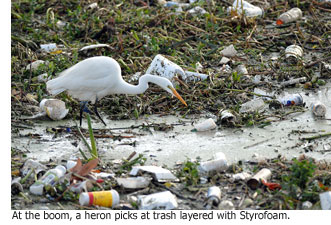
“It’s fulfilling,” Deck says. “My playground is the outdoors so I enjoy doing anything I can to make it better.”
In March, the stakes were historically high for him and the boom, which was first placed across the river 11 years ago as a pilot project. More dammed up debris—460 tons of it—was hauled out of the water than at any time before, tangible evidence of the severity of the March storms. The tonnage included full, uprooted trees. (See video below of the boom in action.)
To be sure, the county, along with its private and government partners, has worked hard to significantly reduce the amount of debris and pollutants flowing into the Los Angeles River from a watershed area of nine million people.
Among other things, county officials have installed 11,000 catch basin screens and other devices in unincorporated areas and have encouraged cities across the region to do the same. They’ve also launched ad campaigns to discourage dumping and educate the public about the relationship between the ocean and what they wash down their driveways.
Still, during the storm season between October and April, all bets are off. Those catch basin inserts, for example, are designed to unlock so greater loads can be accommodated and street flooding can be reduced. And, with as much as 330 million gallons a day flowing through the river, there’s little to do but wait for the debris to hit the boom.
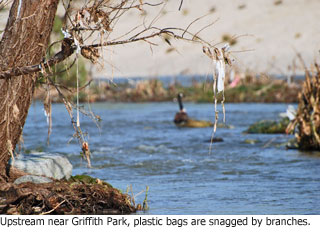 Formerly called the Los Angeles River Trash and Debris Collection System, the boom is operated by a private contractor, Frey Environmental of Newport Beach. On Tuesday, the Board of Supervisors renewed Frey’s contract for an annual sum of $795,000, with a 66-month maximum of about $4.4 million.
Formerly called the Los Angeles River Trash and Debris Collection System, the boom is operated by a private contractor, Frey Environmental of Newport Beach. On Tuesday, the Board of Supervisors renewed Frey’s contract for an annual sum of $795,000, with a 66-month maximum of about $4.4 million.
Since Frey first got the business in 2003, Dave Duncan has been there for the company as one its site operation managers. During the past eight years, he says he’s seen it all, including the sad discovery of a 35-year-old woman’s body. “I thought it was a mannequin,” he says.
Duncan says he understands why there’s so much old junk that ends up at the boom, where it’s lifted into dumpsters by cranes with “grab buckets.”
“If you’re on the low end of things, making $8 an hour and you don’t have money to go to the dump, what do you do? You throw it in the channel and hope for the best,” he says.
The experience and continuity that Duncan has brought to the operation gave a sense of confidence to Deck, who, in 2008, was assigned by the county to work directly with the contractor. “Whenever I’m on the site, Dave is always there,” says Deck, who was promoted last fall and now supervises the person who got his old job.
Deck grew up in central Maine—“in the middle of the woods”—and attended an engineering school in Worcester, Mass. Deck says he was quickly recruited by Los Angeles County before hiring freezes ended such efforts.
The recruiter, a Boston native, took him straight to the beach. “I was sold from there,” says Deck, who had learned to surf while studying abroad in Puerto Rico. An avid skier, too, he now lives in a Hermosa Beach apartment.
In his short number of years here, Deck says he’s had a great vantage point for seeing the success of efforts to keep the ocean cleaner by diverting runoff and trapping debris. “When I go surfing,” he says, “the water quality is significantly better…It’s great to see the system functioning and working.”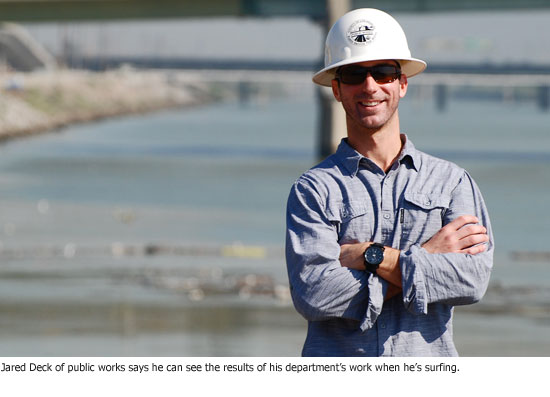
The boom in action

And here’s something you can do: Join the Friends of the Los Angeles River’s 22nd annual cleanup on Saturday, April 30th, from 9 a.m. to noon. The details are here.
Posted 3/31/11




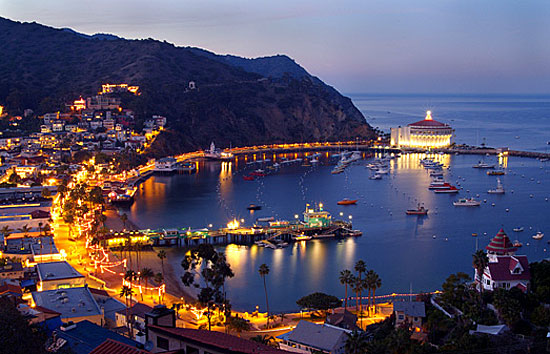
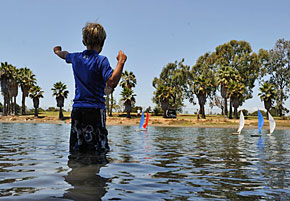
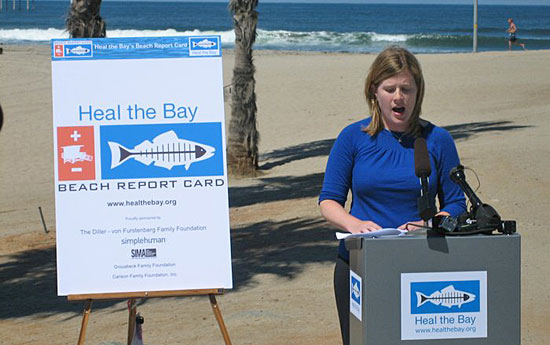







 405 bridge work causes a stink
405 bridge work causes a stink

